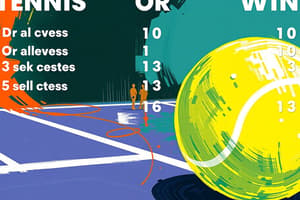Podcast
Questions and Answers
Which forehand grip is considered more extreme and is used by players like Rafael Nadal?
Which forehand grip is considered more extreme and is used by players like Rafael Nadal?
- Continental Forehand
- Semi-Western Forehand
- Western Forehand (correct)
- Eastern Forehand
In the Eastern Forehand grip, which bevel does the index knuckle rest on?
In the Eastern Forehand grip, which bevel does the index knuckle rest on?
- Bevel #2
- Bevel #3 (correct)
- Bevel #5
- Bevel #4
What is a characteristic of the Semi-Western Backhand grip?
What is a characteristic of the Semi-Western Backhand grip?
- Heel pad rests on bevel #2
- The least common backhand grip
- Used for kick serves and spin shots (correct)
- Index knuckle rests on bevel #1
Which grip was introduced by Bill Tilden in the 1920s, increasing topspin and control?
Which grip was introduced by Bill Tilden in the 1920s, increasing topspin and control?
What distinguishes the Eastern Backhand grip from other backhand grips?
What distinguishes the Eastern Backhand grip from other backhand grips?
What makes the Neutral Grip unique compared to the forehand and backhand grips?
What makes the Neutral Grip unique compared to the forehand and backhand grips?
What is another name for the Neutral Forehand grip?
What is another name for the Neutral Forehand grip?
Which knuckle does the index finger rest on in the Neutral Forehand grip?
Which knuckle does the index finger rest on in the Neutral Forehand grip?
Why did the Eastern grip become popular during the grass-court era?
Why did the Eastern grip become popular during the grass-court era?
What is one reason why players use more extreme grips like the Western grip on clay courts?
What is one reason why players use more extreme grips like the Western grip on clay courts?
Why is it essential to keep your hand relaxed on the handle for each grip?
Why is it essential to keep your hand relaxed on the handle for each grip?
What is the recommendation regarding the Continental and Hawaiian forehand grips?
What is the recommendation regarding the Continental and Hawaiian forehand grips?
Study Notes
Tennis Grips: A Guide to Forehand, Backhand, and Neutral Styles
Tennis grips have evolved with changing equipment, court surfaces, and playing styles, allowing players to optimize control, power, and spin. In this guide, we'll discuss the four primary forehand grips and two backhand grips that are essential for understanding and improving your game.
Forehand Grips
-
Continental Forehand The classic grip used for serves, overheads, volleys, and slices. The index knuckle rests on bevel #2, and the heel pad rests on bevel #3.
-
Eastern Forehand Introduced by Bill Tilden in the 1920s, this grip increased topspin and control, making it popular during the grass-court era. The index knuckle rests on bevel #3, and the heel pad rests on bevel #4.
-
Western Forehand A more extreme grip used by players like Rafael Nadal, who play on clay courts. The index knuckle rests on bevel #5, and the heel pad rests on bevel #6.
-
Semi-Western Forehand A grip used by players like Björn Borg in the 1970s. The index knuckle rests on bevel #4, and the heel pad rests on bevel #5.
Backhand Grips
-
Eastern Backhand Used for kick serves and spin shots. The index knuckle rests on bevel #1, and the heel pad rests on bevel #2.
-
Semi-Western Backhand A grip used for top spin shots, power shots, and improved safety and control. The index knuckle rests on bevel #3, and the heel pad rests on bevel #4.
Neutral Grip
- Neutral Forehand (or Continental Forehand) A versatile grip used for a variety of shots. The index knuckle rests on bevel #2, and the heel pad rests on bevel #3.
Adaptability and Evolution
Top players often use multiple grips during a match, adjusting their grip to achieve the desired effect for a specific shot. As equipment and playing styles have evolved, so too have tennis grips. The Eastern grip, for example, became popular during the grass-court era due to its ability to control the ball's bounce. As equipment and playing styles have changed, so too have grips, with many players using more extreme grips like the Western grip on clay courts.
Conclusion
Understanding the different tennis grips is crucial for improving your game. By experimenting with various grips, players can find the best option for their unique playing style. Remember, it's essential to keep your hand relaxed on the handle for each grip, and it's generally recommended to avoid the Continental and Hawaiian forehand grips, which may prevent players from reaching their full potential.
Studying That Suits You
Use AI to generate personalized quizzes and flashcards to suit your learning preferences.
Description
Learn about the different tennis grips for forehand, backhand, and neutral shots, including their history, usage, and impact on playing styles. Discover how top players adapt their grips to optimize control and power during matches.




